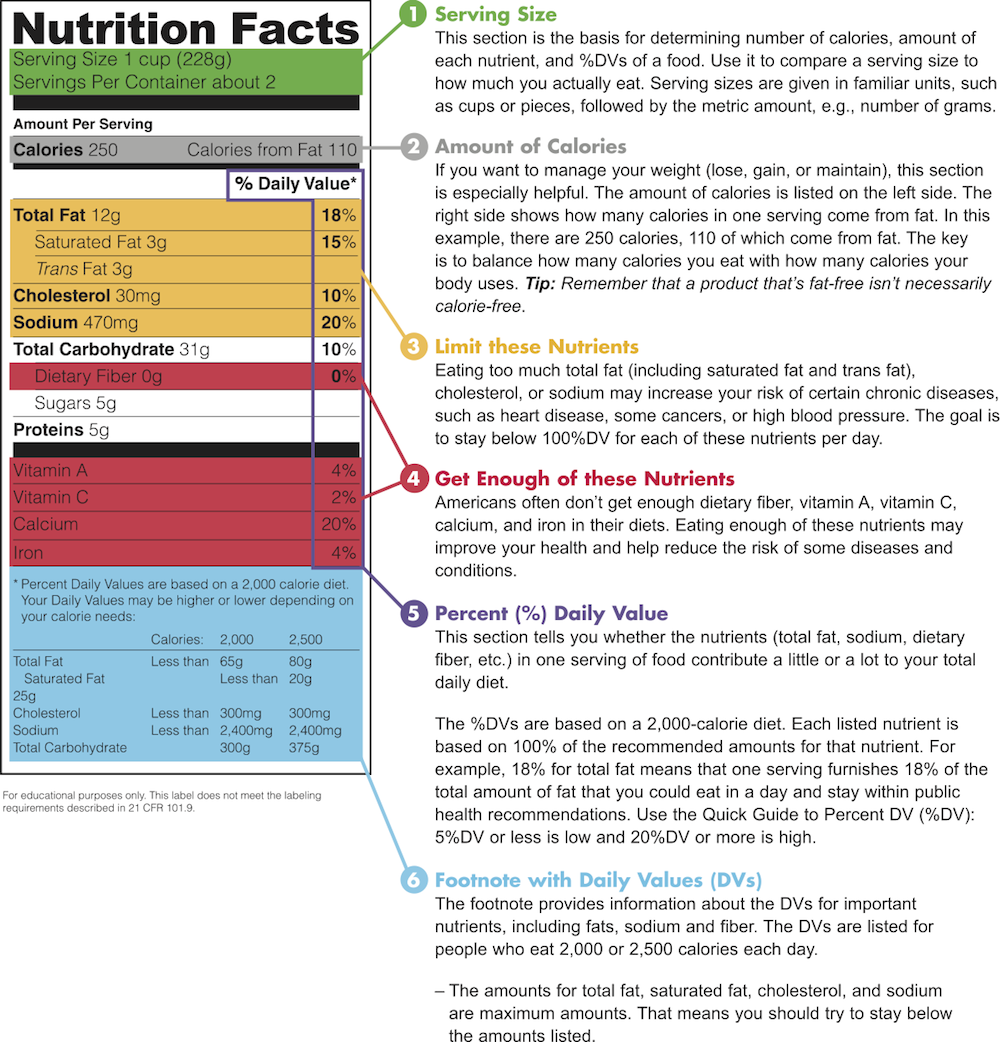Food labels can be intimidating and confusing. Use this step-by-step guide to unravel the mystery.
Step 1: Check serving sizes and calories per serving
All the information on a food label is based on the serving size. Be careful—one serving may be much smaller than you think. If you eat two servings, then you’ve also eaten double the calories, fat, and sodium.
Step 2: Check the fat content
Check the total amount of fat and the type. Most of the fats you eat should be polyunsaturated and monounsaturated fats. High saturated fat consumption is linked to heart disease (1). Try to keep your saturated fat below 10% of your total calories (2). Trans fat is added to foods to make them more shelf stable and is also linked to heart disease (1). You will find trans fat in crackers, cookies, and vegetable based spreads. Trans fat intake should be as low as possible, but the maximum acceptable level has not been established (1). Often trans fat is listed as zero on the nutrition facts label even though it is present in the food. If an ingredient is less than half a gram per serving, food manufacturers may list it as zero (3); this hidden trans fat can add up over the course of a day if you don’t know what to look for. You need to look at the list of ingredients to find the words hydrogenated or partially hydrogenated oils. See the example below for practice reading food labels.
Step 3: Check the cholesterol content
High cholesterol is linked to heart disease (4). All animal products contain cholesterol. Aim for 300 milligrams (mg) or less per day (2).
Step 4: Check the sodium (salt)
Salt contains sodium. High salt intake is associated with high blood pressure (5). Aim for no more than 2,300 milligrams of sodium (about 1 rounded teaspoon of salt) per day (6). Look for foods high in potassium, which counteracts some of sodium’s effects on blood pressure (5).
Step 5: Check the total carbohydrates and sugar
Total carbohydrates include all carbohydrates in the food. Make sure that the majority of carbohydrates are not coming from added sugars. You can do this by first looking at the nutrition facts label to determine the total amount of sugars relative to the carbohydrates. Next, look at the ingredient list to determine if the sugars are naturally occurring (like in fruit) or added (like in many cereals). It is recommended that added sugars supply no more than 25% of total calories (1).
Step 6: Check the fiber
Fiber is important for digestive and heart health. Choose foods that are rich in fiber, such as whole grains, fruits, and vegetables. You need 25 to 38 grams of fiber per day (1). Choose products with more dietary fiber (5 grams or more).
You can also check the percent DV (Daily Value)
But be careful because the percent DV is based on a 2000 calorie per day. The percentages may be higher or lower for you depending on how many calories you are supposed to consume on a daily basis. Foods that have more than at least 10-percent DV of a nutrient are considered a good source of that nutrient, and foods that have 20-percent or more are considered high in that nutrient (3).
Click on the image to enlarge
References
- United States Department of Agriculture – National Agricultural Library. Dietary Reference Intakes: Macronutrients, 2010.Web. 10 March 2013.
- The Centers for Disease Control and Prevention. Nutrition For Everyone: Dietary Fat. The Centers for Disease Control and Prevention, 2013. Web. 25 March 2013.
- Labeling & Nutrition – Food and Drug Administration. Guidance for Industry – A Food Labeling Guide, October 2009. Web. 10 March 2013.
- The Centers for Disease Control and Prevention. Nutrition For Everyone: Vitamins and Minerals; Sodium and Potassium. The Centers for Disease Control and Prevention, 2013. Web. 25 March 2013.
- The Centers for Disease Control and Prevention. Nutrition For Everyone: Vitamins and Minerals; Sodium and Potassium. The Centers for Disease Control and Prevention, 2013. Web. 25 March 2013.
- The Centers for Disease Control and Prevention. Salt: Most Americans Should Consume Less Sodium. The Centers for Disease Control and Prevention, 2013. Web. 25 March 2013.
